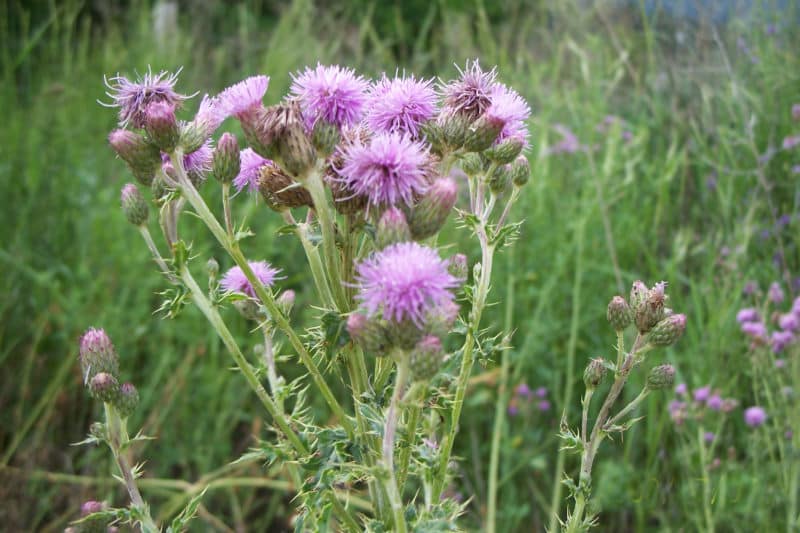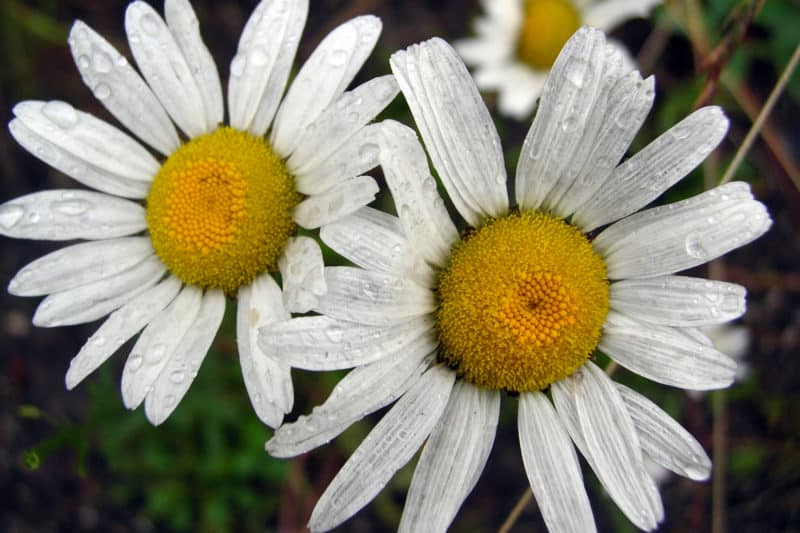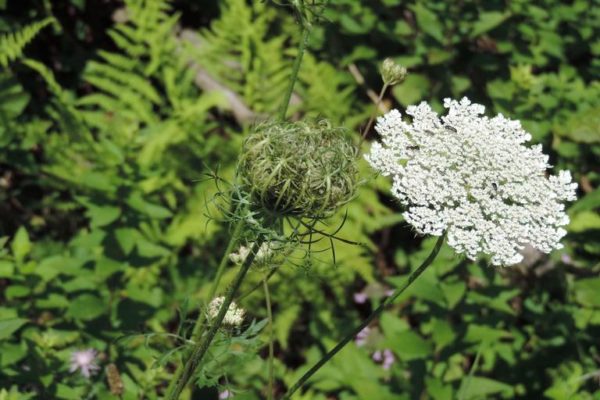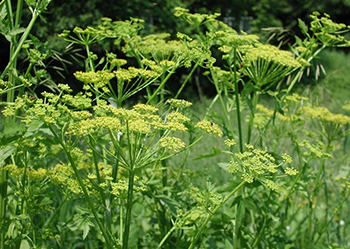A-Z
Disclaimer: do not eat any plant unless you can be certain it has been correctly identified. Do not remove plants from another person's property, or eat plants from polluted areas such as beside roads. Do not consume plants that are being treated with herbicides, and be mindful that consuming any food for the first time may trigger unexpected allergic reactions.
Cirsium Thistles
Canada thistle (Cirsium arvense) and Marsh thistle (Cirsium palustre) are both invasive in AB.

Idenitifcation
Canada thistle: Pp to 2m tall. Shiny green leaves with spiny edges. and white hairs on the underside. Clusters of up to five flowers. You can tell Canada thistle from all similar species by its smooth main stem and small flowers.
Marsh Thistle: Up to 3m tall. Stems grow erect, rarely branching and covered in small spines. Spends its first year as a rosette, where leaves are narrow, spiny with dark purple edges.
Edible Parts
Both: Young leaves and shoots can be eaten raw or cooked. Thorns must be removed before eating.
Canada Thistle (pictured): The entire plant is edible. Roots taste of lettuce. Stems are best eaten before flowers appear, otherwise they are stringy and hollow.Peeled flowers are edible and similar to artichokes, but generally considered "not worth the effort."
Cautions
All thistles are edible, but ensure that you do not harvest native thistle species, which look similar.
Look Alikes
Most thistles in the genus Cirsium
Cooking
A green soup base can be made from blanched leaves.
Common Reed - Phragmites australis

Idenitifcation
Stems smooth, erect, thick (to 10mm in diameter), almost woody, sometimes purplish, up to 4m high, arising from long, firm, extensively creeping rhizomes. Leaf sheaths smooth and hairless with often purple margins. Inflorescence at first purplish, becoming tawny and nearly dark brown at maturity, 12-40cm long with ascending branches and forming a thick, densely branched, silky panicle,
Edible Parts
Entire plant is edible. Roots are high in sugar, edible raw or cooked. Young shoots can be eaten raw, cooked, or pickled.
Cautions
None
Look Alikes
Fairly distinct due to its great height and unique infloresence. It is a good plant for new foragers.
Cooking
Roots can be used like potatoes, but are best before the plant flowers. Young shoots make a nice vegetable and can be used like bamboo. Seeds can be collected at the end of summer.
Eurasian watermilfoil - Myriophyllum spicatum

Idenitifcation
Eurasian watermilfoil has slender stems up to 2.5 m (8.2 ft) long. The plant is a perennial that grows under the water surface and has feather-like green leaves that circle the stem in groups of four or five. Eurasian watermilfoil blooms in late July and early August and has orange/red flowers that are 4–6 mm long. Flowers are produced in the leaf axils on a spike that can be 5–20 cm long, held vertically above the water surface.
Edible Parts
Roots can be eaten raw or cooked.
Cautions
Aquatic plants growing in polluted water sources should never be consumed. After heavy rains, waterways are likely to have increased E. coli levels.
Look Alikes
Parrot feather
Cooking
The root is sweet and crunchy.
Flowering Rush - Butomus umbellatus

Idenitifcation
Found flowering in shallow waters but not deeper sites, 0.3-1.2m tall. 20-50 purple to pink flowers grow in a round cluster that resembles an umbrella on round, erect stem.
Edible Parts
Tuber is high in starch. Seeds are also edible but no specific uses are known.
Cautions
None
Look Alikes
Hardstem bulrush
Giant bur-reed
Sweet flag
Lake sedge
Cooking
Tuber can be cooked like any root vegetable. It should be peeled and the rootlets removed before consumption.
Garlic mustard - Alliaria petiolata

Idenitifcation
In their second year, plants grow from 30–100 cm (rarely to 130 cm) tall. The leaves are stalked, triangular to heart-shaped, 10–15 cm long and 5–9 cm wide, with a coarsely toothed margin (like a saw’s edge). Flowers are small and white with 4 petals arranged in a cross-like shape. The fruit is a pod containing 2 rows of shiny black seeds
Edible Parts
Leaves are best eaten young, as they can get bitter in the summer heat. Roots are spicy, comparable to horseradish. They are best harvested either before or after the plant flowers. Flowers are edible as well, and go nicely in salads.
Cautions
None known (if properly identified).
Look Alikes
Fringecup [!] (shoots only)
Piggy-back Plant (shoots only)
Ground Ivy (shoots only)
Hairy Bittercress
Cooking
Greens can be made into a pesto or a chimichurri.
Shoots can be roasted.
Roots can be used as a horseradish substitute.
Japanese knotweed - Reynoutria japonica

Idenitifcation
Knotweeds have attractive plumes of small, white to green flowers in the spring. Leaves are heart/triangular-shaped, 8-10cm W x 15cm L, and grow in a zigzag pattern in along the plant’s arching stems. Stems grow tall, straight and densely. They are hollow and green, sometimes with reddish-brown speckles growing 1–5m in height. Stems may persist through the winter as bare, grey- or straw-colored hollow stalks.
Edible Parts
The stem of japanese knotweed is similar to bamboo, juicy, tangy, and tastes like rhubarb. It can be eaten cooked or raw.
Cautions
Japanese knotweed can be confused with many species; ensure your ID is correct before consuming.
Knotweed is especially problematic, and is typically treated with harsh hebicides upon discovery. If you find a knotweed growth, ensure that the area is NOT being treated before consumption.
Look Alikes
Young woody shrubs and trees like dogwood and lilac are often confused with knotweed due to its leaf shape.
Oxeye daisy - Leucanthemum vulgare

Idenitifcation
Oxeye daisy has single white flowers at the end of stems that contain 20-30 petals and a yellow center. Stems range from 20 to 80cm in height and have wavy leaves that clasp toward the stem.
Edible Parts
Flowers can be dried and used as tea, and flower buds can be eaten raw or pickled. Roots can be eaten raw in the spring. Leaves can be eaten raw or cooked, but their flavour is not well-loved.
Cautions
Oxeye daisy can cause allergic reactions in people with ragweed or pollen allergies.
Look Alikes
Shasta daisy
Other asters
Scentless chamomile (also invasive), not generally considered edible.
Cooking
Leaves and flower buds can be used in salads.
Flower buds can be pickled.
Flowers can be dried and used in tea.
Queen Anne's Lace - Daucus carota

Idenitifcation
Queen Anne’s lace grows up to 1 m in height and has an umbrella-shaped cluster of white flowers at the top of a hairy stem, usually blooming from May to October. Both the plant and its tap root have a carrot like smell.
Edible Parts
Roots can be used in soups and stews. Leaves can be used in salads, and flower clusters can be batter-fried.
Cautions
Queen Anne's Lace is closely related to poisonous plants. Take great care with identification, and DO NOT eat it unless you are certain you have IDed it properly
Look Alikes
Poison Hemlock [!]
Fool's Parsley [!]
Other wild carrots
St. John’s wort - Hypericum perforatum

Idenitifcation
St. John’s-Wort grows from 0.3–1 m in height and has dark green leaves which show tiny transparent dots when held up to the light. Flowers are bright yellow, with 5 petals each, and grow in clusters at the top of branches. It turns a rusty red colour after finishing flowering late in the summer and autumn.
Edible Parts
Fresh flowers can be made into a tea, or infused into an oil or tincture
Cautions
St. John’s-wort contains a poison that can cause light-coloured farm animals that eat it to have skin burns or blisters when exposed to sunlight. It can also be a skin irritant in some humans.
St. John’s-wort may interact with drugs when consumed, and thus is not recommended for individuals taking medications.
St. John’s-wort may be unsafe to consume in large quantities.
Look Alikes
Tansy ragwort [!]
Other ragworts [!]
Wild Caraway - Carum carvi

Idenitifcation
Wild caraway was introduced to Canada as a spice crop but has escaped cultivation. It is a biennial plant that can quickly outgrow native plants. It can grow in light shade, survive light frost and extra moisture in the soil.
Edible Parts
Whole plant is edible, but the mature seeds at the end of the growing season can be collected and used just like carraway from the store.
Cautions
Be careful not to let seeds fall to the ground while harvesting as it will assist in the spread of the plant.
Look Alikes
Poison Hemlock [!]
Fool's Parsley [!]
Cooking
Seeds can be used just like cultivated caraway.
Wild Parsnip - Pastinaca sativa

Identification
A single green stem, 2-5cm thick, up to 1.5m tall, and smooth with few hairs. Leaves are paired and compound, with mitten-shaped, sharply toothed leaflets. Yellowish-green flowers form clusters 10-20cm wide. Similar to Queen Anne's Lace, but yellow.
Edible Parts
Young leaves and stems are edible, and the root is starchy and edible. It is reportedly much better after the first frost in autumn.
Cautions
Wild parsnips contain a sap that causes contact dermatitis in many people.
Wild parsnip is in the hemlock family. Be careful with ID, especially before the plant develops its characteristic yellow flowers!
Look Alikes
Discernible from most similar species by its yellow flowers.
Angelica
RESEMBLES HEMLOCK WHEN YOUNG
Cooking
Wild parsnip roots can be eaten like cultivated parsnips; they are good baked or fried. Greens can be added to salads and soups.
This list is incomplete. Check back soon for more!
Images and identification information courtesy of the Invasive Species Council of British Columbia, The Ontario Ministry of Agriculture and Rural Affairs, and the Alberta Invasive Species Council.